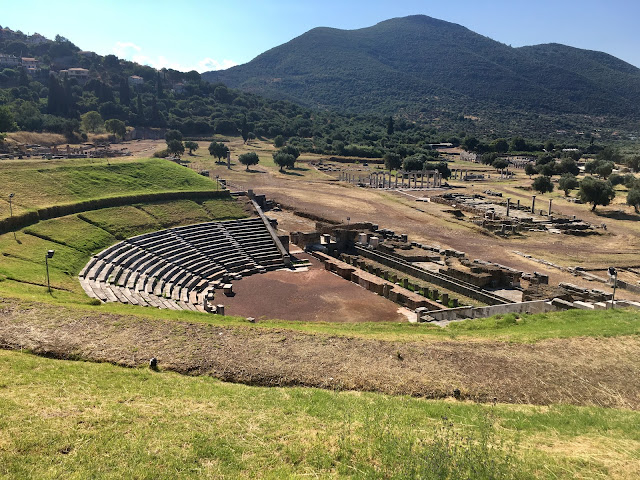We read about Messene and decided yesterday that we don’t know when we’ll be back this way, so we should go! Messene is about an hour and a half from Pylos, so it was a long winding drive this morning. We saw part of Messene as we approached, spread out far and wide on the slopes of Mt. Ithomi, amid olive groves. Ancient Messene became a city during the Bronze Age and over many years following. In 369 BC, it was redone as a defense against the Spartans.
The ruins of Messene are surrounded by a circuit wall, 9 km long (5.5 miles), 23’ wide and 30’ tall, with 30 guard towers. We saw the wall as we neared the entrance to the car park. Just inside the gate was a theater to hold 10,000 spectators, a long agora or market place, various baths - water was plentiful, temple to Artemis, Odeon, a large stadium and gymnasium buildings with water basins, mosaic floors, and so much more. The ruins at Messene are some of the most extensive in all of Greece. We enjoyed every moment of being there!
Next stop was the laundry in Pylos! We dropped our laundry yesterday morning and were told to come after 11 today. It was after 1 when we arrived. We don’t want to leave town without our clothes!
We drove on to Methoni, a fishing and farming village just south of Pylos, at the southernmost point of the west coast of the Peloponnese. We had lunch at a local taverna and then set off to explore. Methoni’s waterfront is anchored by its enormous castle, built by the Venetians in 1209 on top of fortification ruins dating back to the 7th century BC. Until 1204 it was used as a fort by the Byzantines, when it came under Venetian rule. With its natural harbor, the town was an important stop on trade routes between Europe and the East during the Middle Ages. The castle bridge over the moat has 14 arches. Everything was oversized! The center of the castle walls was filled with beautiful wildflowers. And there was a second small castle over a second bridge at the point, called a Bourtzi, dating to 1500. It was pretty amazing!
The ruins of Messene are surrounded by a circuit wall, 9 km long (5.5 miles), 23’ wide and 30’ tall, with 30 guard towers. We saw the wall as we neared the entrance to the car park. Just inside the gate was a theater to hold 10,000 spectators, a long agora or market place, various baths - water was plentiful, temple to Artemis, Odeon, a large stadium and gymnasium buildings with water basins, mosaic floors, and so much more. The ruins at Messene are some of the most extensive in all of Greece. We enjoyed every moment of being there!
Next stop was the laundry in Pylos! We dropped our laundry yesterday morning and were told to come after 11 today. It was after 1 when we arrived. We don’t want to leave town without our clothes!
We drove on to Methoni, a fishing and farming village just south of Pylos, at the southernmost point of the west coast of the Peloponnese. We had lunch at a local taverna and then set off to explore. Methoni’s waterfront is anchored by its enormous castle, built by the Venetians in 1209 on top of fortification ruins dating back to the 7th century BC. Until 1204 it was used as a fort by the Byzantines, when it came under Venetian rule. With its natural harbor, the town was an important stop on trade routes between Europe and the East during the Middle Ages. The castle bridge over the moat has 14 arches. Everything was oversized! The center of the castle walls was filled with beautiful wildflowers. And there was a second small castle over a second bridge at the point, called a Bourtzi, dating to 1500. It was pretty amazing!














